Gold Nanoparticles for Qualitative Detection of Deltamethrin and Carbofuran Residues in Soil by Surface Enhanced Raman Scattering (SERS)
Abstract
1. Introduction
2. Results and Discussion
2.1. Characterization of Gold Nanoparticles
2.2. The SERS Performance of the Colloids
2.3. SERS Signal Enhancement Based on the Proportion of AuNPs and DM and CBF Solution
2.4. Quantitative Determination of DM and CBF in Soil Using SERS
2.5. Quantitative Determination of DM and CBF in Soil with PLS
2.6. Model Accuracy Verification
3. Materials and Methods
3.1. Chemicals
3.2. Instrumentation
3.3. Experimental Methods
3.3.1. Preparation of Gold Nanoparticles
3.3.2. Preparation of Soil Samples
3.3.3. UHPLC Measurement
3.3.4. SERS Measurement
3.4. Spectral Preprocessing Methods
3.5. Partial Least Squares Model
3.6. Model Evaluation Index
4. Conclusions
Supplementary Materials
Author Contributions
Funding
Conflicts of Interest
References
- Yadav, S.K. Pesticide applications - threat to ecosystems. J. Hum. Ecol. 2010, 32, 37–45. [Google Scholar] [CrossRef]
- Hou, R.Y.; Zhang, Z.; Pang, S.; Yang, T.; Clark, J.M.; He, L. Alteration of the non-systemic behavior of the pesticide ferbam on tea leaves by engineered gold nanoparticles. Environ. Sci. Technol. 2016, 50, 6216–6223. [Google Scholar] [CrossRef] [PubMed]
- Xin, C.; Nandong, X.; Shijie, W.; Keji, L.; Fasheng, L. Reductive dechlorination of organochlorine pesticides in soils from an abandoned manufacturing facility by zero-valent iron. Sci. Total Environ. 2010, 408, 3418–3423. [Google Scholar]
- Syed, J.H.; Malik, R.N.; Liu, D.; Xu, Y.; Wang, Y.; Li, J.; Zhang, G.; Jones, K.C. Organochlorine pesticides in air and soil and estimated air–soil exchange in Punjab, Pakistan. Sci. Total Environ. 2013, 444, 491–497. [Google Scholar] [CrossRef]
- Kalia, A.; Gosal, S.K. Effect of pesticide application on soil microorganisms. Arch. Agron. Soil Sci. 2011, 57, 569–596. [Google Scholar] [CrossRef]
- Liu, M.; Hashi, Y.; Song, Y.; Lin, J.-M. Simultaneous Determination of Carbamate and Organophosphorous Pesticides in Fruits and Vegetables by Liquid Chromatography-mass Spectrometry. J. Chromatogr. A 2005, 1097, 183–187. [Google Scholar] [CrossRef]
- Gonçalves, C.; Alpendurada, M.F. Solid-phase micro-extraction-gas chromatography-(tandem) mass spectrometry as a tool for pesticide residue analysis in water samples at high sensitivity and selectivity with confirmation capabilities. J. Chromatogr. A 2004, 1026, 239–250. [Google Scholar] [CrossRef] [PubMed]
- Ali, I.; Aboul-Enein, H.Y. Leaching of Triazine Pesticides in Loamy Soil and their Determination by Reversed Phase HPLC. Int. J. Environ. Anal. Chem. 2001, 81, 315–322. [Google Scholar] [CrossRef]
- Fernandez-Alvarez, M.; Llompart, M.; Lamas, J.P.; Lores, M.; Garcia-Jares, C.; Cela, R.; Dagnac, T. Simultaneous determination of traces of pyrethroids, organochlorines and other main plant protection agents in agricultural soils by headspace solid-phase microextraction–gas chromatography. J. Chromatogr. A 2008, 1188, 154–163. [Google Scholar] [CrossRef] [PubMed]
- Rashid, A.; Nawaz, S.; Barker, H.; Ahmad, I.; Ashraf, M. Development of a simple extraction and clean-up procedure for determination of organochlorine pesticides in soil using gas chromatography-tandem mass spectrometry. J. Chromatogr. A 2010, 1217, 2933–2939. [Google Scholar] [CrossRef] [PubMed]
- Önal, A. A review: Current analytical methods for the determination of biogenic amines in foods. Food Chem. 2006, 103, 1475–1486. [Google Scholar] [CrossRef]
- Didier, B.; Thierry, W.; Magalie, L.J.; Raphaël, A.; Luc, R.; Barthès, B.G. Determination of soil content in chlordecone (organochlorine pesticide) using near infrared reflectance spectroscopy (NIRS). Environ. Pollut. 2009, 157, 3120–3125. [Google Scholar]
- Luo, Q.J.; Lai, J.H.; Ping, Q.; Wang, X.L. An ultrasensitive fluorescent sensor for organophosphorus pesticides detection based on RB-Ag/Au bimetallic nanoparticles. Sensor Actuat. B-Chem. 2018, 263, 517–523. [Google Scholar] [CrossRef]
- Ye, S.; Wheeler, M.C.; McLaughlan, J.R.; Tamang, A.; Diggle, C.P.; Cespedes, O.; Markham, A.F.; Coletta, P.L.; Evans, S.D. Developing Hollow-Channel Gold Nanoflowers as Trimodal Intracellular Nanoprobes. Int. J. Mol. Sci. 2018, 19, 2327. [Google Scholar] [CrossRef]
- Sharma, B.; Frontiera, R.R.; Henry, A.I.; Ringe, E.; Duyne, R.P.V. SERS: Materials, applications, and the future. Mater. Today 2012, 15, 16–25. [Google Scholar] [CrossRef]
- Huiyuan, G.; Zhiyun, Z.; Baoshan, X.; Arnab, M.; Craig, M.; White, J.C.; Lili, H. Analysis of Silver Nanoparticles in Antimicrobial Products Using Surface-Enhanced Raman Spectroscopy (SERS). Environ. Sci. Technol. 2015, 49, 4317. [Google Scholar]
- Ru, E.C.L.; Etchegoin, P.G. Principles of Surface-Enhanced Raman Spectroscopy: And Related Plasmonic Effects; Elsevier Science and Technology: Amsterdam, The Netherland, 2009. [Google Scholar]
- Xu, S.; Man, B.; Jiang, S.; Wang, J.; Wei, J.; Xu, S.; Liu, H.; Gao, S.; Liu, H.; Li, Z. Graphene/Cu nanoparticle hybrids fabricated by chemical vapor deposition as surface-enhanced Raman scattering substrate for label-free detection of adenosine. ACS Appl. Mater. Interfaces 2015, 7, 10977–10987. [Google Scholar] [CrossRef] [PubMed]
- Jiang, J.; Zou, S.; Ma, L.; Wang, S.; Liao, J.; Zhang, Z. Surface-Enhanced Raman Scattering Detection of Pesticide Residues Using Transparent Adhesive Tapes and Coated Silver Nanorods. ACS Appl. Mater. Interfaces 2018, 10, 9129–9135. [Google Scholar] [CrossRef]
- Grabar, K.C.; Freeman, R.G.; Hommer, M.B.; Natan, M.J. Preparation and Characterization of Au Colloid Monolayers. Anal. Chem. 1995, 67, 735–743. [Google Scholar] [CrossRef]
- Dong, T.; Lin, L.; He, Y.; Nie, P.; Qu, F.; Xiao, S. Density Functional Theory Analysis of Deltamethrin and Its Determination in Strawberry by Surface Enhanced Raman Spectroscopy. Molecules 2018, 23, 1458. [Google Scholar] [CrossRef]
- Chen, J.; Huang, Y.; Kannan, P.; Zhang, L.; Lin, Z.; Zhang, J.; Chen, T.; Guo, L. Flexible and Adhesive Surface Enhance Raman Scattering Active Tape for Rapid Detection of Pesticide Residues in Fruits and Vegetables. Anal. Chem. 2016, 88, 2149–2155. [Google Scholar] [CrossRef]
- Chen, Z.; Li, Y.; Peng, Y.; Xu, T.; Dhakal, S.; Chao, K.; Qin, J. Research on identification and determination of mixed pesticides in apples using surface enhanced Raman spectroscopy. In Proceedings of the Spie Sensing Technology + Applications, Baltimore, MD, USA, 13 May 2015. [Google Scholar]
- Zhu, W.L.; Tan, X.J.; Chum, M.P.; Gu, J.D.; Jiang, H.L.; Chen, K.X.; Felder, C.E.; Silman, I.; Sussman, J.L. How Does Ammonium Interact with Aromatic Groups? A Density Functional Theory (DFT/B3LYP) Investigation. J. Phys. Chem. A 2000, 104, 9573–9580. [Google Scholar] [CrossRef]
- Perna, G.; Lasalvia, M.; D’Antonio, P.; Quartucci, G.; Capozzi, V. Characterization of human cells exposed to deltamethrin by means of Raman microspectroscopy and atomic force microscopy. Vib. Spectrosc. 2011, 57, 55–60. [Google Scholar] [CrossRef]
- Huang, S.G.; Hu, J.P.; Liu, M.H.; Wu, R.M.; Wang, X.B. Density Functional Theory Calculation and Raman Spectroscopy Studies of Carbamate Pesticides. Spectrosc. Spect. Anal. 2017, 37, 766–771. [Google Scholar]
- Sackmann, M.; Materny, A. Surface enhanced Raman scattering (SERS)—A quantitative analytical tool? J. Raman Spectrosc. 2010, 37, 305–310. [Google Scholar] [CrossRef]
- Li, M.; Wang, J.; Du, F.; Diallo, B.; Xie, G.H. High-throughput analysis of chemical components and theoretical ethanol yield of dedicated bioenergy sorghum using dual-optimized partial least squares calibration models. Biotechnol. Biofuels 2017, 10, 206. [Google Scholar] [CrossRef]
- Łozowicka, B.; Rutkowska, E.; Jankowska, M. Influence of QuEChERS modifications on recovery and matrix effect during the multi-residue pesticide analysis in soil by GC/MS/MS and GC/ECD/NPD. Environ. Sci. Pollut. Res. 2017, 24, 7124–7138. [Google Scholar] [CrossRef]
- Wang, J.; Zhang, P.; He, T.; Xin, H.; Liu, F. Surface-enhanced resonance raman study on adsorption of cyanine dye onto silver chloride colloids. J. Phys. Chem. 1988, 92, 1942–1945. [Google Scholar] [CrossRef]
- Suman, S.; Jha, R.K. A new technique for image enhancement using digital fractional-order Savitzky–Golay differentiator. Multidim. Syst. Sign. Process. 2017, 28, 709–733. [Google Scholar] [CrossRef]
- Fearn, T.; Riccioli, C.; Garrido-Varo, A.; Guerrero-Ginel, J.E. On the geometry of SNV and MSC. Chemometr. Intell. Lab. 2009, 96, 22–26. [Google Scholar] [CrossRef]
- Fernández, D.C.D.R.; Boom, P.D.; Zingg, D.W. Corner-corrected diagonal-norm summation-by-parts operators for the first derivative with increased order of accuracy. J. Comput. Phys. 2017, 330, 902–923. [Google Scholar] [CrossRef]
- Durán-Merás, I.; Muńoz de la Peña, A.; Espinosa-Mansilla, A.; Salinas, F. Multicomponent determination of flavour enhancers in food preparations by partial least squares and principal component regression modelling of spectrophotometric data. Analyst 1993, 118, 807–813. [Google Scholar] [CrossRef]
- Ali, F.; Rasoolimanesh, S.M.; Sarstedt, M.; Ringle, C.; Ryu, K. An assessment of the use of partial least squares structural equation modeling (PLS-SEM) in hospitality research. Int. J. Contemp. Hosp. Manag. 2018, 30, 514–538. [Google Scholar] [CrossRef]
- D’Acqui, L.P.; Pucci, A.; Janik, L.J. Soil properties prediction of western Mediterranean islands with similar climatic environments by means of mid-infrared diffuse reflectance spectroscopy. Eur. J. Soil Sci. 2010, 61, 865–876. [Google Scholar] [CrossRef]

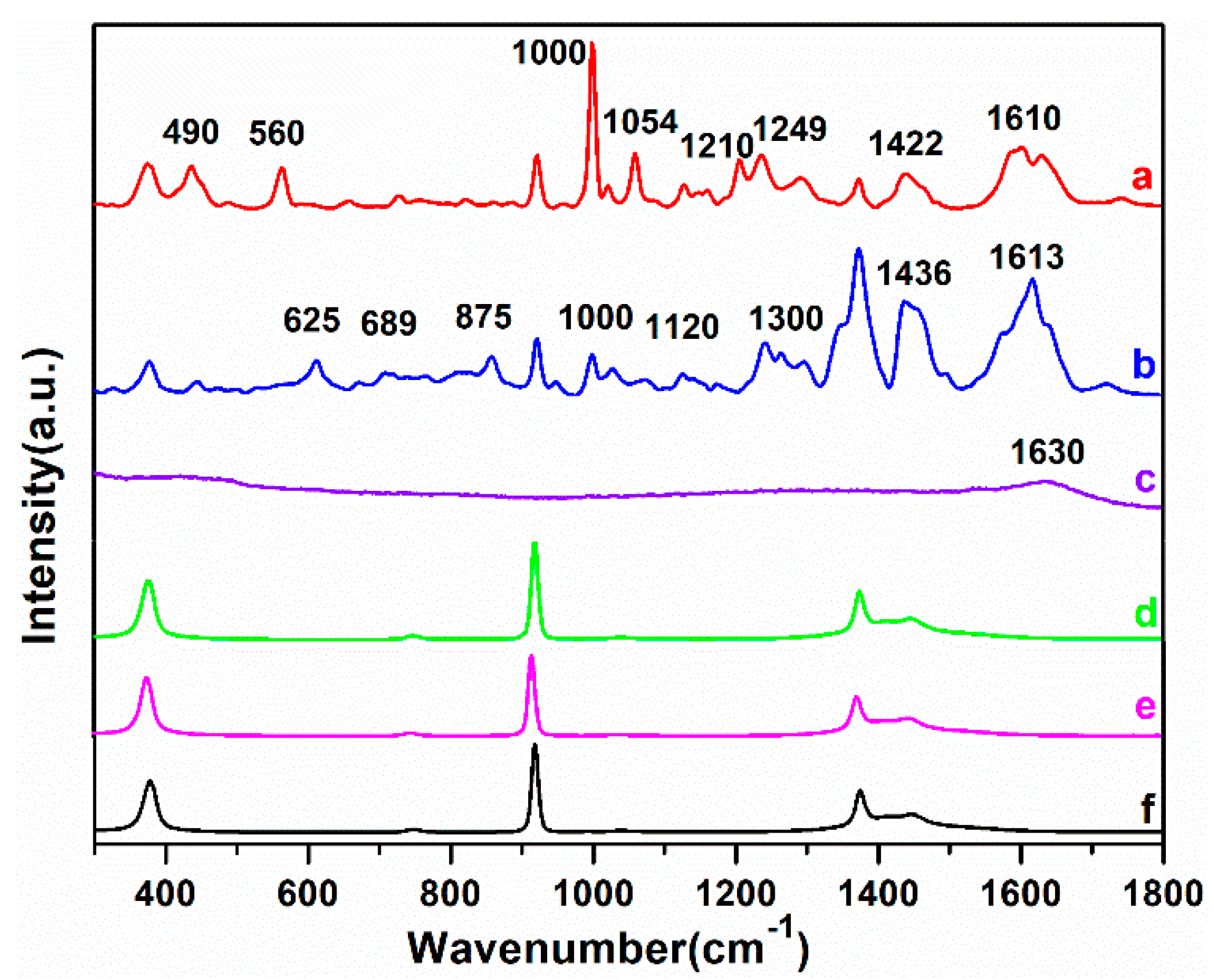
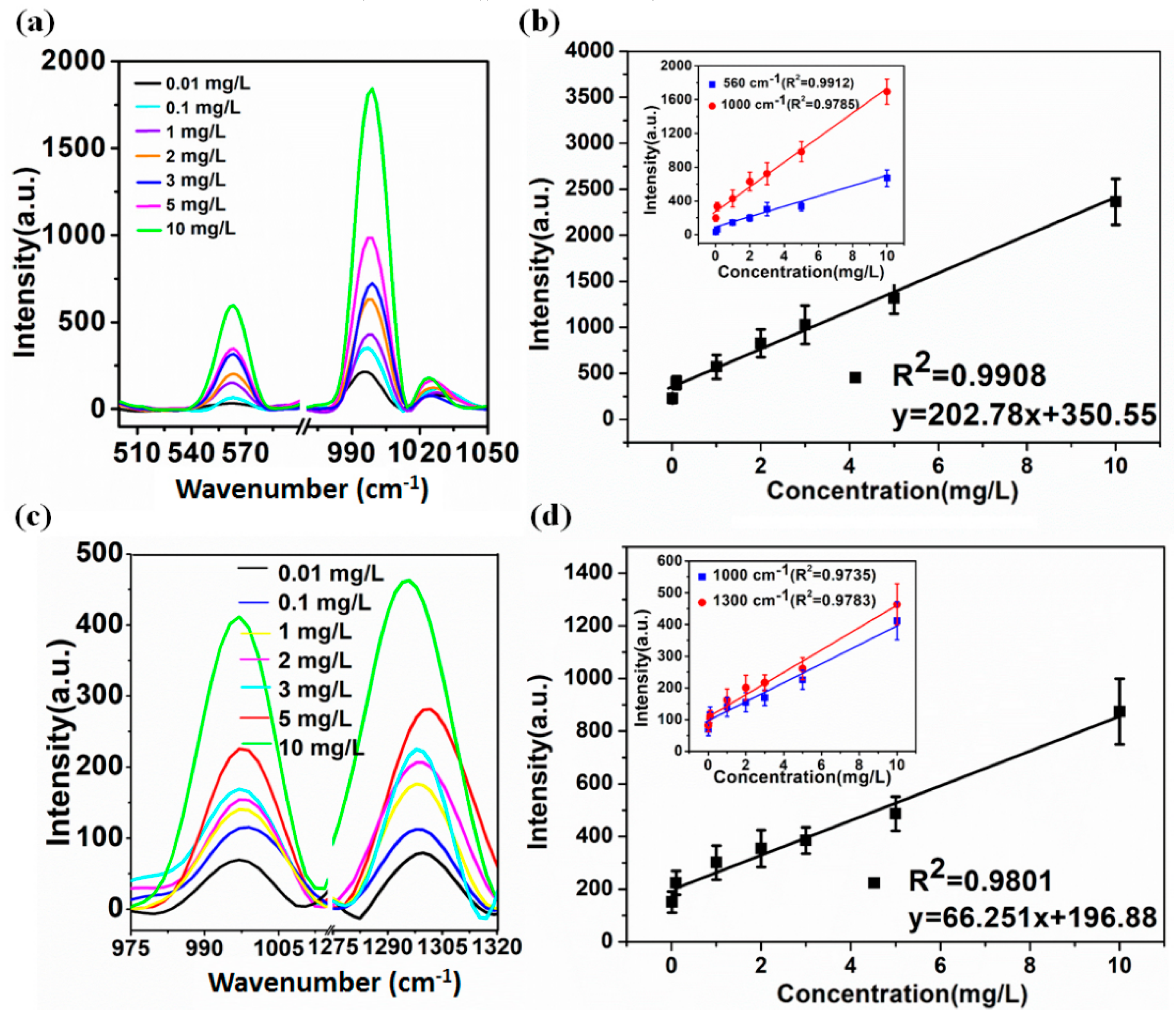
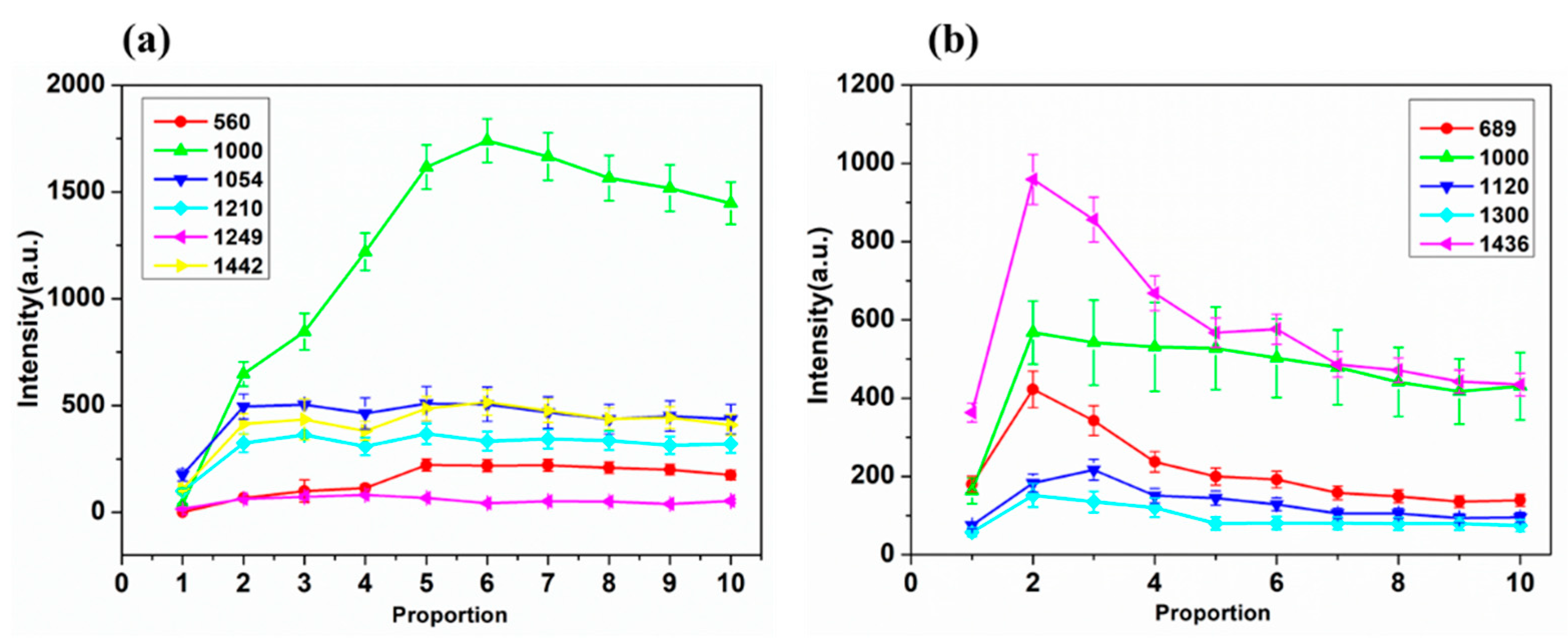
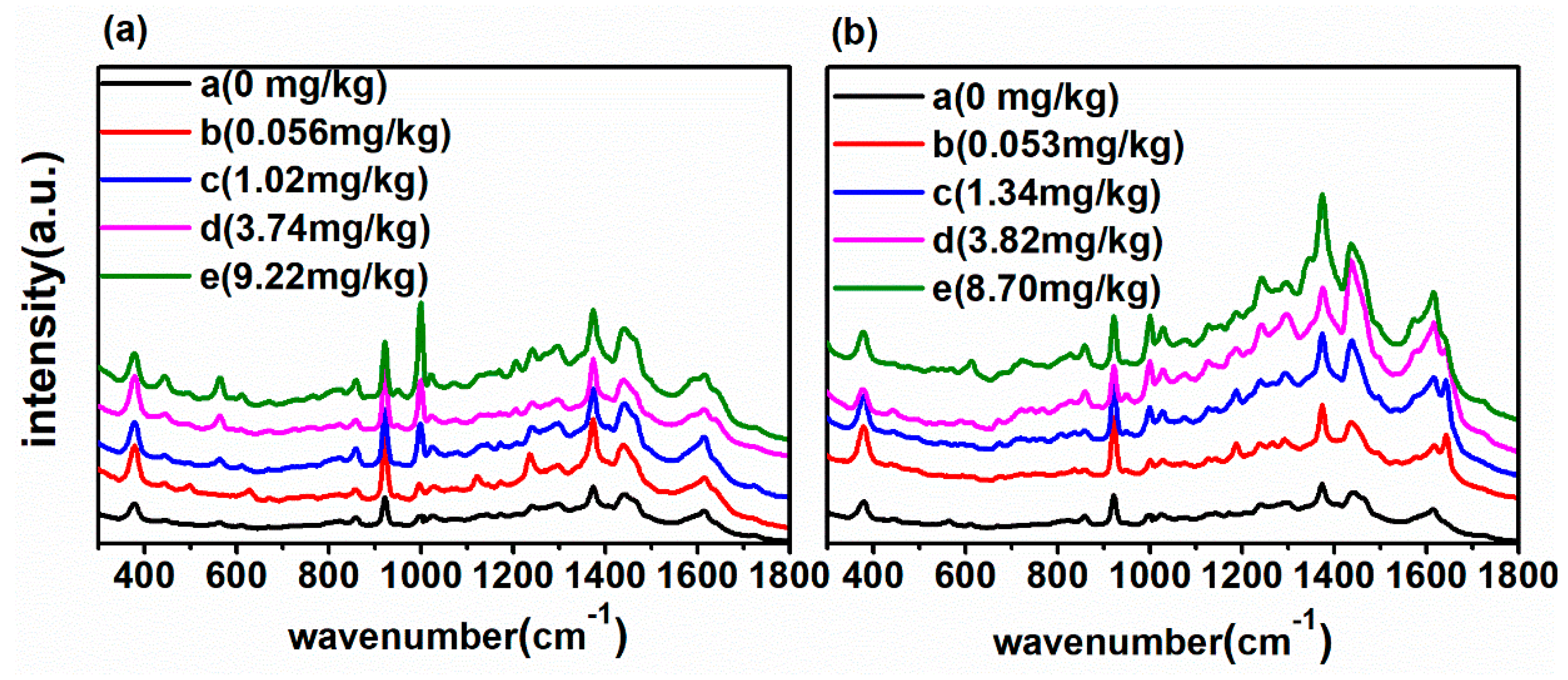
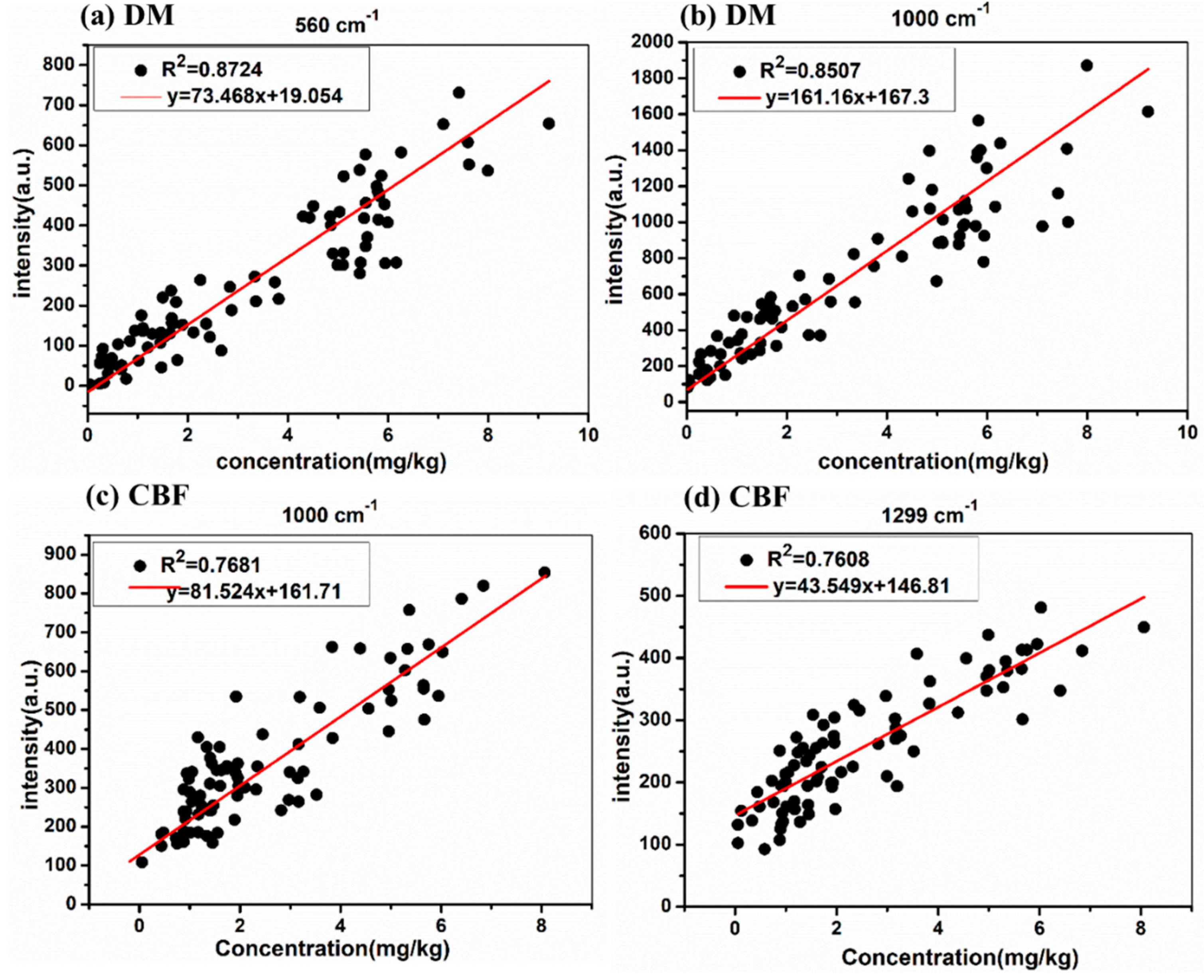
| Deltamethrin | Carbofuran | ||||||
|---|---|---|---|---|---|---|---|
| SERS (cm−1) | DFT (cm−1) | Powder (cm−1) | Assignment | SERS (cm−1) | DFT (cm−1) | Powder (cm−1) | Assignment |
| 490 | 500 | 495(w) | υring | 625 | 633 | 631(w) | υring+υ(C–C–C) |
| 560 | 553 | 554(m) | υ(C–Br) + υ(C–C) | 689 | 711 | 690(m) | υring |
| 1000 | 987 | 1000(vs) | υring+ δ(C–C) | 875 | 872 | 876(m) | υ(N–C=O) |
| 1054 | 1065 | 1045(w) | υ(C–C) | 1000 | 1005 | 1009(m) | υring+ δ(C–C) |
| 1210 | 1191 | 1206(m) | υ(C–C) | 1120 | 1112 | 1110(m) | δ(CH3) |
| 1249 | 1248 | 1250(w) | υring+δ(C–H) | 1300 | 1304 | 1295(m) | δ(CH3) |
| 1442 | 1440 | 1446(w) | δ(CH3) | 1436 | 1473 | 1446(s) | υ(C4H4O) |
| 1610 | 1613 | 1610(m) | υ(C=C) | 1613 | 1625 | 1603(s) | υbreathe |
| Samples | Added (mg/L) | UHPLC (mg/kg) | UHPLC RSD (%) | UHPLC Recovery (%) |
|---|---|---|---|---|
| DM | 0–10 | 0–9.21 | 0.36–20.3 | 69.8–98.36 |
| CBF | 0–10 | 0–8.01 | 0.51–23.1 | 70.2–90.52 |
| Sorts | Baseline Correction | Pretreatment | Calibration | Prediction | |||
|---|---|---|---|---|---|---|---|
| Rc2 | RMSEC | Rp2 | RMSEP | RPD | |||
| DM | Before | SG | 0.9031 | 0.7229 | 0.8800 | 0.856 | 2.8239 |
| MSC | 0.9027 | 0.6992 | 0.8540 | 0.944 | 2.6108 | ||
| SNV | 0.8942 | 0.7774 | 0.8932 | 0.875 | 2.6049 | ||
| 1st-Der | 0.8892 | 0.8205 | 0.9124 | 0.690 | 3.1761 | ||
| After | SG | 0.9752 | 0.3821 | 0.9059 | 0.673 | 3.0182 | |
| MSC | 0.9841 | 0.3002 | 0.9176 | 0.604 | 3.1741 | ||
| SNV | 0.9769 | 0.3640 | 0.9099 | 0.716 | 3.0944 | ||
| 1st-Der | 0.9686 | 0.4231 | 0.9151 | 0.677 | 3.2258 | ||
| CBF | Before | SG | 0.7515 | 0.9752 | 0.6593 | 1.160 | 1.7411 |
| MSC | 0.7517 | 0.9685 | 0.6768 | 1.170 | 1.7307 | ||
| SNV | 0.7441 | 0.9498 | 0.6757 | 1.210 | 1.7584 | ||
| 1st-Der | 0.6869 | 1.0200 | 0.7868 | 1.080 | 2.0414 | ||
| After | SG | 0.8558 | 0.9740 | 0.8350 | 0.568 | 2.3299 | |
| MSC | 0.9016 | 0.7568 | 0.8517 | 0.560 | 2.3827 | ||
| SNV | 0.8516 | 0.9626 | 0.8212 | 0.602 | 2.0977 | ||
| 1st-Der | 0.8904 | 0.8025 | 0.7843 | 0.900 | 1.8150 | ||
| Samples | Added (mg/L) | Peaks (mg/L) | Peaks Recovery (%) | PLS (mg/L) | PLS Recovery (%) | UHPLC (mg/L) | UHPLC Recovery (%) |
|---|---|---|---|---|---|---|---|
| DM | 0.5 | 0.38 | 76.0 | 0.51 | 106.0 | 0.48 | 96.0 |
| 2 | 2.12 | 106.0 | 2.30 | 115.0 | 1.70 | 85.0 | |
| 4 | 3.30 | 82.5 | 3.36 | 84.0 | 3.81 | 95.3 | |
| 8 | 6.81 | 85.2 | 6.74 | 84.3 | 7.59 | 97.9 | |
| CBF | 0.5 | 0.42 | 84.0 | 0.4 | 80.0 | 0.43 | 86.0 |
| 2 | 1.65 | 82.5 | 1.75 | 87.5 | 1.86 | 93.0 | |
| 4 | 3.33 | 83.3 | 3.35 | 83.8 | 3.91 | 97.8 | |
| 8 | 8.21 | 102.6 | 7.01 | 87.6 | 7.48 | 93.5 |
© 2019 by the authors. Licensee MDPI, Basel, Switzerland. This article is an open access article distributed under the terms and conditions of the Creative Commons Attribution (CC BY) license (http://creativecommons.org/licenses/by/4.0/).
Share and Cite
He, Y.; Xiao, S.; Dong, T.; Nie, P. Gold Nanoparticles for Qualitative Detection of Deltamethrin and Carbofuran Residues in Soil by Surface Enhanced Raman Scattering (SERS). Int. J. Mol. Sci. 2019, 20, 1731. https://doi.org/10.3390/ijms20071731
He Y, Xiao S, Dong T, Nie P. Gold Nanoparticles for Qualitative Detection of Deltamethrin and Carbofuran Residues in Soil by Surface Enhanced Raman Scattering (SERS). International Journal of Molecular Sciences. 2019; 20(7):1731. https://doi.org/10.3390/ijms20071731
Chicago/Turabian StyleHe, Yong, Shupei Xiao, Tao Dong, and Pengcheng Nie. 2019. "Gold Nanoparticles for Qualitative Detection of Deltamethrin and Carbofuran Residues in Soil by Surface Enhanced Raman Scattering (SERS)" International Journal of Molecular Sciences 20, no. 7: 1731. https://doi.org/10.3390/ijms20071731
APA StyleHe, Y., Xiao, S., Dong, T., & Nie, P. (2019). Gold Nanoparticles for Qualitative Detection of Deltamethrin and Carbofuran Residues in Soil by Surface Enhanced Raman Scattering (SERS). International Journal of Molecular Sciences, 20(7), 1731. https://doi.org/10.3390/ijms20071731







